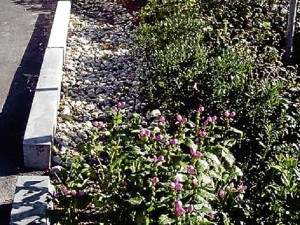Green: Protection against calamity

RAIN gardens are planted depressions in the landscape that allow runoff to be collected and absorbed. They solve drainage issues, collect and filter pollutants, keep our water clean, provide habitat for wildlife and protect our water resources. Photo:wgbh.org
The strongest argument today for the need for green buildings is the possibility of storm, flooding and power blackout. There is also the possibility of terrorist attack that can destroy electric power distribution.
If there is no objection to that, we may proceed to say that in these events homes, schools, public buildings, office buildings and emergency shelters must maintain livable conditions to survive indefinite periods of loss of electricity, or water.
Need for green buildings
The vulnerability of buildings to storms, floods, terrorist attack causing power outage and water shortage brings about the need for green and sustainable buildings. Every building must have the ability to maintain critical life-support conditions if electricity and water services get cut off.
Our acceptance of the reality of global warming leads us to expect more severe and frequent storms, and we have now to incorporate storm resiliency in building design.
Green or sustainable building design and construction practices and technologies assure the built environment with “passive survivability,” a term coined in the United States by Alex Wilson of the Environmental Building News after hurricane Katrina.
This will include proper building orientation, insulation, low emissivity glass, sunshades, daylighting and natural ventilation, photovoltaic power systems, dual-flush toilets and rainwater collection.
Site selection is the first green consideration, and we may ask some questions. What is the land’s carrying capacity, or what will this site require us to do, permit us to do, help us to do? Does it lend itself to development? Is the air clean? How steep is the slope, and are the soils strong and stable to build on? What happens to storm water runoff? Is water in the site contaminated? What wildlife, plants and habitats will be affected? How will future development on adjacent land affect the site? Are strong electromagnetic fields present?
Daylighting, natural ventilation
Green buildings emphasize the use of as much daylight as possible. This leads naturally to lower operating costs, increased worker productivity and good health. Well-placed windows save cooling energy costs. They also capture views, provide ventilation and daylighting, very helpful during power blackouts.
Renewable energy
Fuel supply interruption is another reason for us to adopt green building design. Using renewable sources like photovoltaics or PV, wind and biomass to generate electricity on-site can assure power supply for critical needs.
Rainwater management
Rainwater collection and storage reduces water runoff and more importantly saves water for cleaning and watering plants.
In some advanced countries, they divert rainwater through an underground tank into the aquifer. They also require private development to submit rainwater management strategy in the zoning and building permit process for developments beyond a certain amount of building floor area.
The allowable difference between permeable or porous soil and impermeable or cemented areas in city and community centers has given rise to award-winning street-edge rain gardens. Even schoolchildren are encouraged to participate in vegetable rain gardens in school parking lots, and empty spaces in school grounds.
Sewage overflow during major storms threaten drinking water supply. Therefore outdated and overburdened pipe infrastructure in cities and towns has to be replaced. Some transform part of impervious areas in combined sewer system drainage areas into planted acres that filter or store rainfall.
For comments or inquiries, e-mail amadodejesus@gmail. com.














